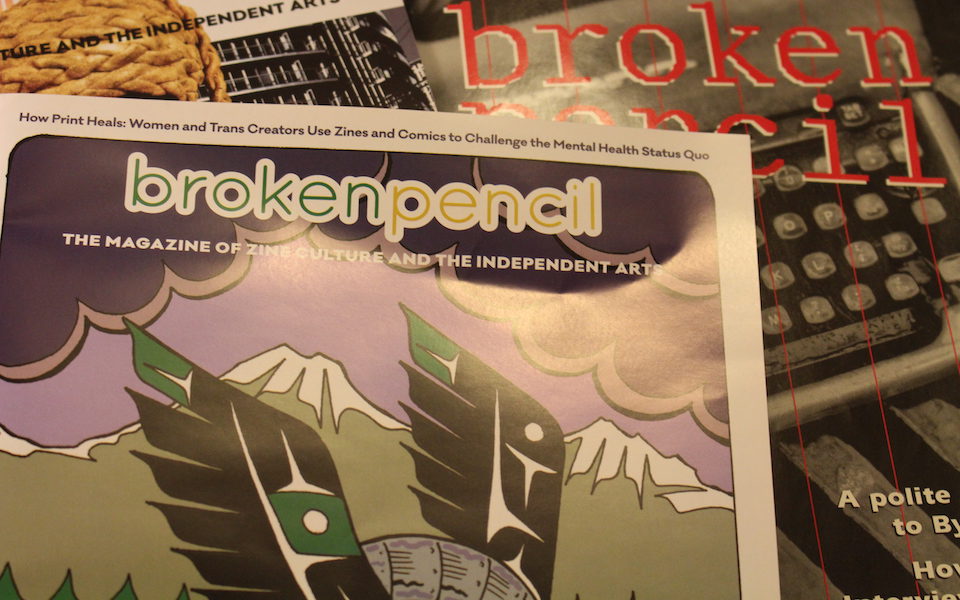
Hal Niedzviecki stayed up all night with his designer and co-founder, cutting and pasting strips of paper before the first issue of Broken Pencil –an alternative magazine about zine culture and the independent arts– was sent to the printer. It was 1995, and desktop publishing hadn’t made its complete arrival yet. Niedzviecki–who was criticized for writing about a cultural appropriation prize last spring– had recently graduated from the University of Toronto where he worked at the student newspaper The Varsity and its magazine.
At the time Niedzviecki wrote short stories and they were published in strange places —underground independent magazines where no one was able to find them. He had an idea to run a magazine that would celebrate interesting and alternative material. Both Niedzviecki and Hilary Clark —who is now a producer for TVO’s The Agenda— put about $1,000 of their own finances into the magazine to start for printing and other costs. Niedzviecki wrote most of the first couple of issues of Broken Pencil himself before the quarterly got its feet off the ground.
“I knew how to make a magazine, but I didn’t have any idea how to sell or run the magazine, so that was where all the mistakes were made,” Niedzviecki said. He contacted what is now known as Magazines Canada, which put Broken Pencil on its distribution list. The magazine was also sold to local, independent bookstores and former music powerhouse Tower Records.
In the same year it launched, so did the Canzine festival. Broken Pencil did not have a large marketing budget but needed a way to get the magazine’s name out, Niedzviecki says. Canzine was the perfect option, and fell right into Broken Pencil’s mandate. Canzine is an annual festival, where people are able to showcase their own zines. These are self-published mini magazines where individuals showcase art, activism, personal stories or fiction. Over the years, Broken Pencil garnered subscribers and advertisers, and after about 10 to 15 of its first issues, Niedzviecki was able to stop writing most of the magazine’s content. He began hiring people and commissioning writers. Broken Pencil now employs five people on a freelance, part-time basis, and there are between 20 to 30 contributors in each issue.
The journalism industry keeps hearing the same phrase over and over: Print is dying. Magazines and newspapers are shutting down because of declining revenue. In 2017 a Torstar-Postmedia deal resulted in the collapse of over 30 newspapers. In 2016, Rogers Media announced that it would stop printing Flare, Sportsnet, MoneySense, and Canadian Business, making them online-only publications. At the same time, Maclean’s, Chatelaine, and Today’s Parent reduced the amount of print editions published per year.
So when large, widely distributed magazines are suffering, how do independent magazines stay afloat? Smaller magazines, like Broken Pencil and Shameless, fulfill mandates that help to amplify diverse voices. These alternative publications are important, especially when it comes to reading and hearing stories that are not typically represented in mainstream.
Grant funding makes up 30 per cent of their magazine’s revenue, while subscriptions are another 30 per cent, says Julia Horel, the publisher of Shameless, an independent feminist magazine. The magazine’s additional revenue comes from donors, advertising, newsstand sales, and an annual fundraiser. In addition, Broken Pencil also receives a number of grants from the Ontario Arts Council, the Canada Council for the Arts , and the Department of Canadian Heritage. Grants make up the majority of the magazine’s revenue, but subscription revenue is a close second, Niedzviecki says. Other revenue is generated through advertising, newsstand sales, Canzine, the Broken Pencil Zine Awards, and the Indie Writer’s Deathmatch contest.
Since Horel became the publisher for Shameless in 2014, she applied to a couple of grants provided by the Ontario Arts Council. For the last three years the magazine has received an annual grant, which helps to pay the magazine’s freelance staff and contributors a small stipend. Freelance staff, including editors and managers, are paid $50 three times per year when an issue is released, while contributors are paid $50 per feature and $25 per column. “The magazine has always been volunteer-run, and that’s pretty critical in terms of how we survive,” Horel said. The grants also helped set up Shameless’s youth advisory board, which meets periodically to plan each issue’s editorial direction. On the other hand, grants make up roughly 50 per cent of Broken Pencil’s funding. The magazine compensates its writers and illustrators between $50 to $400, depending on the length of the piece.
In order to continue to survive on shoestring budgets, both Broken Pencil and Shameless hope to maintain subscription revenues. “I would love to get us to a point where we have enough subscribers to print more copies,” Horel said. The magazine currently has no office, or paid part-time or full-time staff, and Horel says she hopes this also changes in the future. Similarly, Broken Pencil introduced the zine awards in 2017, expanded Canzine to Calgary that same year, and released its first coloured issue this past fall. Next year, Niedzviecki hopes to expand Canzine to one or two more Canadian cities. Currently, it makes appearances in Calgary, Toronto, Vancouver, and Winnipeg. Broken Pencil is also always updating its website and distributes its email newsletter to 20,000 people every week.
“You got to do all these things to keep yourself relevant, and to keep people remembering that you’re there and you’re a magazine,” Niedzviecki said.